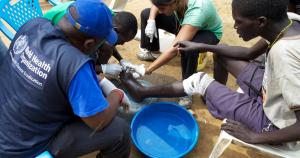Strengthening surveillance for Guinea worm disease in Northern Namibia
A case of Guinea worm disease (GWD) was confirmed in Angola in June 2018. The case, an eight-year girl, hails from the Cunene Province in Angola, which borders Ohangwena and Omusati Regions in Namibia. In response, Angolan authorities, with WHO support, carried out further case searches in three southern provinces of the country, including Cunene. During the exercise, a suspected case was detected who, at the time of her illness, had travelled to Engela in Ohangwena Region for a wedding and was treated at the Engela District Hospital. Although this suspect was not confirmed to be a case of GWD by investigators from both Angola and Namibia, has alerted Namibian Authorities. Namibia has never been endemic for GWD and was certified free in 1999. Given that GWD has been confirmed in its immediate northern neighbouring province of Cunene in Angola, it is important to do a thorough case search along the Angolan border to determine whether GWD exists in Northern Namibia, as part of efforts to strengthen GWD surveillance.
WHO, with support from its Regional Office for Africa, trained 10 Ministry of Health field epidemiologists and other partners to conduct active case search in Omusati and Ohangwena Regions along the Angolan border from 25 February to 8 March 2019. The objective will be to actively search for cases in all the seven districts in the two targeted regions, determine the risk of infection and spread, and strengthen the capacity of health workers to manage rumours and cases of GWD.
What is Guinea Worm Disease?
- Guinea-worm disease is caused by the parasitic worm known as Dracunculus medinensis or "Guinea-worm".
- It can be 600 to 800 mm long and 2 mm wide
- The female can carry up to 3 million ‘eggs’
- Infection is usually acquired through drinking contaminated water from ponds or shallow open wells.
- It takes up to a year for symptoms and signs to show. This is because the female takes 9 – 14 months to emerge usually from the feet releasing thousands of larvae (worms).
- This usually causes a very painful oedema (collection of excess watery fluids resulting in a swelling on the affected area), a blister and an ulcer
- Other symptoms include fever, nausea and vomiting
There is no drug to prevent or heal GWD; treatment is by daily wound dressing, careful surgical extraction, until the worm is completely pulled out. Painkillers may be required for pain and antibiotics for infected wound.
Guinea-worm disease is rarely fatal. Frequently, however, the patient remains sick for several months because of pain and complications from secondary infections and worm rupture. Dracunculiasis is easy to eliminate and has been targeted for eradication. A single case of dracunculiasis is considered an outbreak, requiring emergency response within 24 hours.
The report of the case search will determine how the Ministry will proceed; however, health education in the targeted districts will continue.



